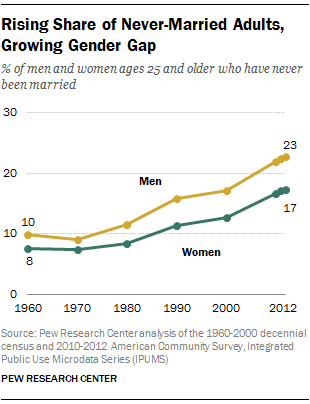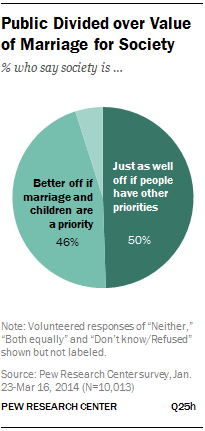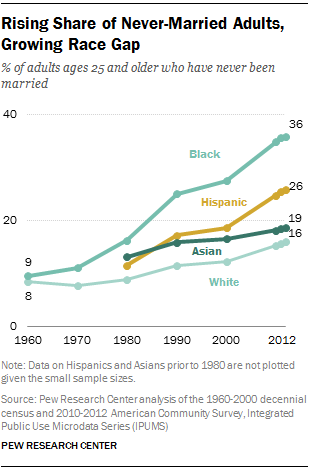

In addition, shifting public attitudes, hard economic times and changing demographic patterns may all be contributing to the rising share of never-married adults.
Opinions on this issue differ sharply by age—with young adults much more likely than older adults to say society is just as well off if people have priorities other than marriage and children. Fully two-thirds of those ages 18 to 29 (67%) express this viewpoint, as do 53% of those ages 30 to 49. Among those ages 50 and older, most (55%) say society is better off if people make it a priority to get married and have children.
What Never-Married Adults Are Looking For in a (Potential) Spouse

Never-married adults—whether male or female—place a much lower priority on finding a partner who shares their moral and religious beliefs, has a similar educational pedigree or comes from the same racial or ethnic background.
Among those who have never been married but say they may eventually like to wed, three-in-ten say the main reason they are not married is that they have not found someone who has what they are looking for in a spouse. Nearly as many (27%) say they are not financially prepared for marriage, and 22% say they are too young or not ready to settle down. There are no significant differences between never-married men and women in this regard.
Never-Married Adults Face Changing Economic Realities

As the share of never-married adults has climbed, the economic circumstances faced by both men and women have changed considerably. Labor force participation among men—particularly young men—has fallen significantly over the past several decades. In 1960, 93% of men ages 25 to 34 were in the labor force; by 2012 that share had fallen to 82%. And among young men who are employed, wages have fallen over the past few decades. For men ages 25 to 34, median hourly wages have declined 20% since 1980 (after adjusting for inflation). Over the same period, the wage gap between men and women has narrowed. In 2012, among workers ages 25 to 34, women’s hourly earnings were 93% those of men. In 1980, the ratio was less than 70%.1
The new Pew Research survey findings suggest that never-married women place a high premium on finding a spouse with a steady job. However, the changes in the labor market have contributed to a shrinking pool of available employed young men.
Among never-married adults ages 25 to 34, the number of employed men per 100 women dropped from 139 in 1960 to 91 in 2012, despite the fact that men in this age group outnumber young women in absolute numbers. In other words, if all never-married young women in 2012 wanted to find a young employed man who had also never been married, 9% of them would fail, simply because there are not enough men in the target group. Five decades ago, never-married young women had a much larger pool of potential spouses from which to choose.2
Despite the survey finding that few Americans say it is very important to them to find someone of the same racial or ethnic background to marry, the vast majority of new marriages (85%) take place between people of the same race and ethnicity.3 The pool of employed men has shrunk for both black and white young adults since 1960, but the decline has been more pronounced among blacks.
It is important to note that never-married young adults are not necessarily restricting their choice of a potential spouse to those who have never been married, nor are they limited to a spouse within their age group. Among all unmarried adults ages 25 to 34 in 2012, 15% have been divorced, separated or widowed, and these men and women are potentially in the marriage market as well.
Gender, Education and Marriage
The relationship between education and marital status has changed considerably over time, and the patterns among men and women have reversed. In 1960, men of various education levels were about equally likely to have never been married. Today, there is considerable disparity in the shares of never-married men along educational lines. Men with a high school education or less are much more likely than men with advanced degrees to have never married (25% vs. 14%).

For women, the opposite trend has occurred. In 1960, women with advanced degrees (31%) were about four times as likely to have never married as women with a high school education or less (7%). These educational gaps have closed over time, and today women of different educational backgrounds are almost equally likely to have never been married.

Over this same period, women have made significant gains in higher education. The number of young women attending college has grown steadily, and by the mid-1990s, women began to outpace men in college enrollment and college completion rates. In 2013, among women ages 25 to 29, 37% had at least a bachelor’s degree, compared with 30% of men in the same age range.
The changing gender patterns in the link between education and marital status have contributed to an educational mismatch between never-married men and women. Today, never-married women ages 25 and older are more educated overall than never-married men: one-third of these women have either a bachelor’s or advanced degree, compared with one-quarter of never-married men ages 25 and older. In 1960, never-married men and women were much more similar in terms of their educational attainment.4
Race, Ethnicity and Marriage

The share of never-married adults has gone up for all major racial and ethnic groups in the U.S., but the rate of increase has been most dramatic among blacks. Among black adults ages 25 and older, the share who has never been married has quadrupled over the past half century—from 9% in 1960 to 36% in 2012. For whites, the share has doubled (from 8% to 16%).
Among Hispanics and Asian Americans, whose numbers have swelled in recent decades due to a large influx of immigrants, the share of adults who have never married also has increased. Among Hispanic adults, the share has doubled since 1980 (12% vs. 26%). And for Asian American adults, the share has gone up from 13% in 1980 to 19% in 2012.
In most racial and ethnic groups, men are more likely than women to have never been married. The major exception is among blacks. In 2012, roughly equal shares of black men (36%) and black women (35%) ages 25 and older had never been married. In 1960, black men were more likely than black women to have never been married (12% vs. 8%). Among whites, Hispanics and Asians, men are more likely than women to have never been married, and the gender gap among whites and Hispanics has widened in recent decades.
Will Today’s Never-Married Adults Eventually Marry?

Today’s young adults are slow to tie the knot, and a rising share may end up not getting married at all. According to Pew Research projections based on census data, when today’s young adults reach their mid-40s to mid-50s, a record high share (25%) is likely to have never been married.
Looking at cohorts of young adults ages 25 to 34 going back to 1960, there has been a steady increase since 1970 in the share that remains never married by the time the cohort reaches ages 45 to 54.
In 1960, some 12% of adults ages 25 to 34 had never been married. After 10 years, when that group was between the ages of 35 and 44, 7% of them still hadn’t wed. By 1980, when they were in their mid-40s to -50s, only 5% had still never married. The next cohort starting in 1970 followed a similar trajectory. However, each new cohort of young adults since then has had a higher share of never-married members than the cohort that came before it. If current trends continue, 25% of young adults in the most recent cohort (ages 25 to 34 in 2010) will have never married by 2030. That would be the highest share in modern history.
While it is certainly true that some adults marry for the first time after the age of 54, the chances of this occurring are relatively small. In 2012, there were 71 first-time newlyweds for every 1,000 never-married adults ages 25 to 34.5 The rate dropped to 40 per 1,000 among never-married adults ages 35 to 44, 16 per 1,000 among never-married adults ages 45 to 54, and only 7 per 1,000 among never-married adults ages 55 and older.
The remainder of this report explores the various factors that may be contributing to the rising share of never-married adults and the changing characteristics of that population.
Chapter 1 of the report is based on a new Pew Research survey of 2,003 adults and looks at public views on marriage as well as the attitudes of never-married adults themselves, including reasons that they are not married and qualities they are looking for in a potential spouse or partner. Chapter 2 presents trends in the share of never-married Americans by gender, age and cohort. It also includes projections of the share of today’s never-married young adults that will eventually marry. Chapter 3 explores the overall marriage market for all unmarried adults. Chapter 4 focuses on never-married young adults ages 25 to 34 and explores the marriage market for this age group. Finally, Chapter 5 looks at the demographic profile of never-married Americans over time as well as in comparison to their married peers.
Other key findings
- For young adults who want to get married, financial security is a significant hurdle. Compared with their older counterparts, young adults who have never been married are more likely to cite financial security as the main reason for not being currently married (34% of those ages 25 to 34 compared with 20% of those 35 and older).
- Previously married adults show less interest in marriage than do never-married adults. Only one-in-five previously married adults (21%) say they would like to marry again, while a plurality (45%) say they do not want to get married again. (An additional 31% are not sure.) There is a large gender gap on this question. Previously married women are much less likely than their male counterparts to say they would like to get married again someday (15% of women compared with 29% of men). Fully 54% of these women say they are not interested in getting remarried (30% of men say the same).
- Never-married and previously married adults have different demographic profiles. Compared with never-married adults, previously married adults are much older and somewhat less educated. In 2012, among those who were ages 25 and older, the median age of previously married adults was 58, while the median age for never-married adults was 35. About one-in-five divorced, separated or widowed adults (19%) are college graduates, compared with 28% of never-married adults. In addition, among those ages 25 to 64, men outnumber women by a large margin among never-married adults (125 men for every 100 women), but men are outnumbered by women among previously married adults (71 men for every 100 women).
- Among young, never-married blacks, women outnumber men. For blacks ages 25 to 34, there are 92 never-married men for every 100 never-married women. When employment status is taken into consideration, there are 51 employed young black men for every 100 young black women. Among never-married white, Hispanic and Asian American young adults, the ratio of employed men to women is roughly equal—100 men for every 100 women. Several decades ago, there was a surplus of young employed men among whites, and for every 100 young black women, there were nearly 90 employed black men.
- Among never-married young adults with post-graduate degrees, women outnumber men by a large margin. There are 77 never-married men ages 25 to 34 with post-graduate degrees for every 100 women with similar educational credentials. Among never-married young adults with a bachelor’s degree, the male-to-female ratio is 102 men for every 100 women.
Note 1: Cohabitation in the U.S.
Many never-married young adults are not “single.” According to Pew Research analysis of the March 2013 Current Population Survey, about 24% of never-married Americans ages 25 to 34 currently live with a partner. According to data from the National Center for Health Statistics, among women who first cohabited at age 25 to 29, their premarital cohabitation relationship typically lasted about a year and a half (17 months). Research finds that after one year, about three-in-ten young adults get married, 9% break up the relationship and 62% continue cohabiting. By the third year, nearly six-in-ten (58%) married, 19% broke up and 23% remained in the relationship.*
According to the same data from the National Center for Health Statistics, nearly half of women ages 15 to 44 (48%) have cohabited with a partner (before marriage). Women with less than a high school diploma (70%) are more likely to have lived with an unmarried partner than those with a college degree or higher (47%). Among women who are in a cohabiting relationship, college-educated women are more likely than their counterparts who do not have a high school diploma to get married after three years (53% vs. 30%).
* Copen, Casey E., Kimberly Daniels and William D. Mosher. 2013. “First Premarital Cohabitation in the United States: 2006-2010 National Survey of Family Growth.” National Health Statistics Report, No. 64. April. (http://www.cdc.gov/nchs/data/nhsr/nhsr064.pdf)
Note 2: A Note About LGBT Adults
Lesbian, gay, bisexual and transgender (LGBT) adults are included but not analyzed separately in this study. Previous survey findings suggest that 3.5% of adults self-identified as gay, lesbian or bisexual.** Among 650,000 same-sex couple households identified in the 2010 Census, about 80% are cohabiting partners and 20% are married partners.*** However, recent studies suggest that the 2010 Census overestimated the population of same-sex couples. In 2010, 73% of same-sex married couples counted in the census turned out to be opposite-sex married couples.
As of September 2014, same-sex marriage is legal in 19 states and Washington, D.C. A 2013 Pew Research Center survey found that 16% of LGBT adults—mostly bisexuals with opposite sex partners—reported being currently married, compared with about half of all adults. A total of 60% of LGBT survey respondents were either married or said they would like to marry one day, compared with 76% of the general public.
** Gates, Gary J. 2011. “How Many People are Lesbian, Gay, Bisexual and Transgender?” Los Angeles: The Williams Institute. April. (http://williamsinstitute.law.ucla.edu/research/census-lgbt-demographics-studies/how-many-people-are-lesbian-gay-bisexual-and-transgender/)
[Link will download a Word document]
About the Data
Findings in this report are based mainly on two sources: data from a recent Pew Research Center survey, decennial censuses and the American Community Survey.
Public Opinion Survey data: The Pew Research survey was conducted May 22-25 and May 29-June 1, 2014, with a nationally representative sample of 2,003 adults ages 18 and older, including 436 adults who have never been married. A total of 1,000 interviews were completed with respondents contacted by landline telephone and 1,003 with those contacted on their cellular phones. Data are weighted to produce a final sample that is representative of the general population of adults in the United States. Survey interviews were conducted in English and Spanish under the direction of Princeton Survey Research Associates International. Margin of sampling error is plus or minus 2.5 percentage points for results based on the total sample at the 95% confidence level.
Census data: Unless otherwise noted, all demographic analyses in this report are based on Decennial Censuses (1960, 1970, 1980, 1990, and 2000) and the American Community Surveys (2010, 2011, 2012). The data set was obtained from the IPUMS-USA database* (http://www.ipums.org) and constructed by the Pew Research Center.
The American Community Survey is a household survey developed by the U.S. Census Bureau to replace the long form of the decennial census program. It is collected throughout the year using mailed questionnaires, telephone interviews and visits from Census Bureau field representatives to about 3 million household addresses annually.
Analyses of unmarried Americans are based on adults ages 25 and older for consistency in comparison over time. Analyses of young adults focus on those ages 25 to 34. “Unmarried” adults comprise those who have never married and those who are divorced, separated or widowed.
Among young adults ages 25 to 34, 58% were unmarried in 2012, with the vast majority of them (85%) never having been married. Projections about the share of young adults remaining never married by 2020 and 2030 are based on the share of the previous cohort of never-married adults at the same age, assuming the same rate continues.
Lesbian, gay, bisexual and transgender (LGBT) adults are included but are not analyzed separately.
All estimates have been weighted to reflect the actual population.
[Machine-readable database]
A Note on Terminology
This report focuses primarily on “never-married” adults. The meaning of that term is just as it sounds—adults who have never been married. They are part of a broader universe of adults who are not currently married. For the most part all of the adults in this broader universe are referred to as “unmarried.” They may have never been married or they may be divorced, separated or widowed. “Single” is used interchangeably with “unmarried” in this report, though we are aware that people who are unmarried and living with a partner may not think of themselves as “single.”
“Previously married adults” refer to adults who are currently divorced, separated or widowed.
All references to whites, blacks and Asians are to the non-Hispanic components of those populations. Asians also include Pacific Islanders. Hispanics are of any race.




